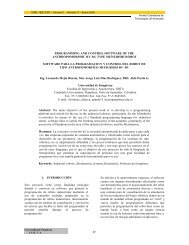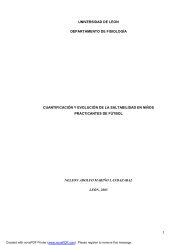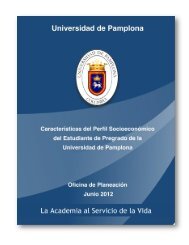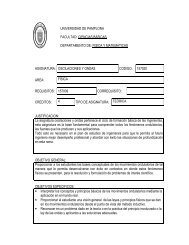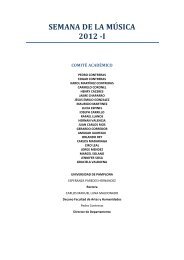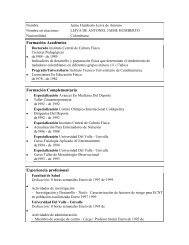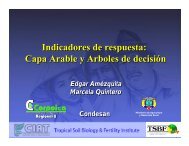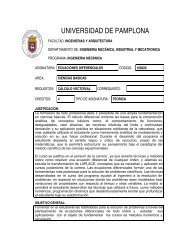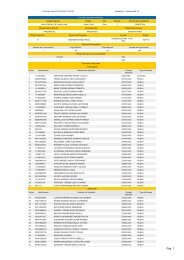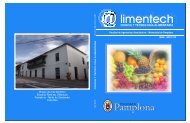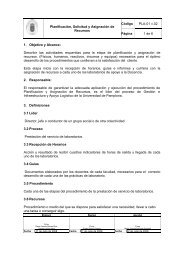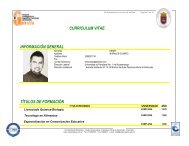transferencia de calor - Bibliotecas de la Universidad de Pamplona
transferencia de calor - Bibliotecas de la Universidad de Pamplona
transferencia de calor - Bibliotecas de la Universidad de Pamplona
You also want an ePaper? Increase the reach of your titles
YUMPU automatically turns print PDFs into web optimized ePapers that Google loves.
1<br />
UNIVERSIDAD DE PAMPLONA<br />
FACULTAD: INGENIERIAS Y ARQUITECTURA<br />
DEPARTAMENTO DE: INGENIERIA MECÁNICA, INDUSTRIAL Y MECATRONICA<br />
PROGRAMA: INGENIERIA MECANICA<br />
ASIGNATURA: TRANSFERENCIA DE CALOR CODIGO: 197029<br />
AREA:<br />
BASICAS DE INGENIERÍA<br />
REQUISITOS: 197022 CORREQUISITO: 197028<br />
CREDITOS: 4 TIPO DE ASIGNATURA: TEORICA<br />
JUSTIFICACION:<br />
El curso <strong>de</strong> <strong>transferencia</strong> <strong>de</strong> <strong>calor</strong> permite al estudiante conocer los fundamentos<br />
re<strong>la</strong>cionados con <strong>la</strong> razón <strong>de</strong> intercambio <strong>de</strong> <strong>calor</strong> entre cuerpos. La termodinámica<br />
proporciona una cuantificación <strong>de</strong>l <strong>calor</strong> a transmitir mientras <strong>la</strong> <strong>transferencia</strong> <strong>de</strong><br />
<strong>calor</strong> proporciona los mecanismos para llevar a cabo esta transmisión <strong>de</strong> energía.<br />
Es posible afirmar que <strong>la</strong> importancia <strong>de</strong> este curso es brindar al estudiante el<br />
“cómo” realizar un intercambio <strong>de</strong> <strong>calor</strong>.<br />
OBJETIVO GENERAL:<br />
Conocer los mecanismos básicos <strong>de</strong> <strong>transferencia</strong> <strong>de</strong> <strong>calor</strong> y diversas aplicaciones<br />
<strong>de</strong>l tema en <strong>la</strong> ingeniería.<br />
OBJETIVOS ESPECIFICOS:<br />
& Conocer los principios básicos y <strong>la</strong>s analogías <strong>de</strong> los tres mecanismos <strong>de</strong><br />
<strong>transferencia</strong> <strong>de</strong> <strong>calor</strong>: conducción, convección y radiación.<br />
& Consi<strong>de</strong>rar <strong>la</strong> conducción <strong>de</strong> <strong>calor</strong> en estado estable en sistemas simples en los<br />
cuales <strong>la</strong> temperatura y el <strong>calor</strong> son funciones <strong>de</strong> una simple coor<strong>de</strong>nada.<br />
& Estudiar los métodos para analizar <strong>la</strong> conducción <strong>de</strong> <strong>calor</strong> en dos y tres<br />
dimensiones.<br />
& Conocer los fundamentos y aplicaciones <strong>de</strong> problemas <strong>de</strong> <strong>transferencia</strong> <strong>de</strong> <strong>calor</strong><br />
en los cuales <strong>la</strong>s variaciones transitorias <strong>de</strong> temperatura son importantes.<br />
& Analizar <strong>la</strong> radiación como un mecanismo <strong>de</strong> <strong>transferencia</strong> <strong>de</strong> <strong>calor</strong>.<br />
& Estudiar <strong>la</strong>s características y principios <strong>de</strong>l mecanismo <strong>de</strong> <strong>transferencia</strong> <strong>de</strong> <strong>calor</strong><br />
<strong>de</strong>nominado convección.<br />
COMPETENCIAS
2<br />
& Capacidad <strong>de</strong> comprensión y p<strong>la</strong>nteamiento <strong>de</strong> alternativas <strong>de</strong> solución <strong>de</strong><br />
problemas utilizando <strong>la</strong> <strong>transferencia</strong> <strong>de</strong> <strong>calor</strong>.<br />
& Capacidad <strong>de</strong> organización y responsabilidad <strong>de</strong>l trabajo para <strong>de</strong>sarrol<strong>la</strong>r <strong>la</strong>s<br />
tareas con el máximo <strong>de</strong> eficacia y eficiencia.<br />
& Disposición y habilidad para co<strong>la</strong>borar <strong>de</strong> manera coordinada en <strong>la</strong>s tareas<br />
realizadas conjuntamente por un equipo <strong>de</strong> personas para conquistar un<br />
objetivo propuesto.<br />
& Capacidad <strong>de</strong> realizar una tarea <strong>de</strong> forma in<strong>de</strong>pendiente, ejecutándo<strong>la</strong> <strong>de</strong><br />
principio hasta el final, sin necesidad <strong>de</strong> recibir ninguna ayuda o apoyo.<br />
& Capacidad <strong>de</strong> iniciativa o habilidad y disposición para tomar <strong>de</strong>cisiones sobre<br />
propuestas o acciones.<br />
UNIDAD 1: PROCESOS DE TRANSFERENCIA DE CALOR<br />
TEMA<br />
HORAS DE<br />
CONTACTO<br />
DIRECTO<br />
HORAS DE<br />
TRABAJO<br />
INDEPENDIENTE<br />
DEL<br />
ESTUDIANTE.<br />
Modos <strong>de</strong> flujo <strong>de</strong> <strong>calor</strong>. 2 4<br />
Leyes básicas <strong>de</strong> <strong>la</strong> transmisión <strong>de</strong> <strong>calor</strong>. 3 6<br />
Combinación <strong>de</strong> los mecanismos básicos <strong>de</strong><br />
<strong>transferencia</strong> <strong>de</strong> <strong>calor</strong>.<br />
Lectura en inglés:<br />
Heat Flow Measurements<br />
http://www.hukseflux.com/heat%20flux/flux.htm<br />
Mecanismo <strong>de</strong> control: discusión en c<strong>la</strong>se.<br />
UNIDAD 2: CONDUCCION DE CALOR ESTABLE UNIDIMENSIONAL<br />
TEMA<br />
3 6<br />
HORAS DE<br />
CONTACTO<br />
DIRECTO<br />
HORAS DE<br />
TRABAJO<br />
INDEPENDIENTE<br />
DEL ESTUDIANTE.<br />
Conducción <strong>de</strong> <strong>calor</strong> en pare<strong>de</strong>s simples. 2 4<br />
Conducción <strong>de</strong> <strong>calor</strong> en pare<strong>de</strong>s compuestas. 3 6<br />
Sistemas con fuente <strong>de</strong> <strong>calor</strong> 2 4<br />
Transferencia <strong>de</strong> <strong>calor</strong> a través <strong>de</strong> superficies<br />
extendidas.<br />
Lectura en inglés:<br />
Radiators<br />
http://www.caterpil<strong>la</strong>r.com/services/shared/parts_n_servi<br />
ce/03_engine_parts/03_spec_sheet_library/pdf/pehp804<br />
1.pdf<br />
Mecanismo <strong>de</strong> control: exposición por parte <strong>de</strong>l<br />
estudiante.<br />
5 10
3<br />
UNIDAD 3: CONDUCCION DE CALOR BI Y TRIDIMENSIONAL<br />
TEMA<br />
HORAS DE<br />
CONTACTO<br />
DIRECTO<br />
HORAS DE<br />
TRABAJO<br />
INDEPENDIENTE<br />
DEL<br />
ESTUDIANTE.<br />
Conducción <strong>de</strong> <strong>calor</strong> en dos y tres dimensiones. 2 4<br />
Soluciones analíticas 6 12<br />
Lectura en inglés:<br />
Termal Mo<strong>de</strong>lling<br />
http://imartinez.etsin.upm.es/mod1/Thermal%20mo<strong>de</strong>llin<br />
g.htm<br />
Mecanismo <strong>de</strong> control: Ejercicio propuesto para<br />
sustentación.<br />
UNIDAD 4: FLUJO DE CALOR EN ESTADO INESTABLE<br />
TEMA<br />
HORAS DE<br />
CONTACTO<br />
DIRECTO<br />
HORAS DE<br />
TRABAJO<br />
INDEPENDIENTE<br />
DEL<br />
ESTUDIANTE.<br />
Conducción <strong>de</strong> <strong>calor</strong> en estado inestable. 4 8<br />
Aplicaciones <strong>de</strong>l flujo <strong>de</strong> <strong>calor</strong> transitorio. 4 8<br />
Lectura en inglés:<br />
Transient Simu<strong>la</strong>tions of Unsteady Heat Transfer<br />
inTurbulent Pipe Flow.<br />
Mecanismo <strong>de</strong> control: e<strong>la</strong>boración <strong>de</strong> re<strong>la</strong>toría<br />
UNIDAD 5: TRANSFERENCIA DE CALOR POR RADIACION<br />
TEMA<br />
HORAS DE<br />
CONTACTO<br />
DIRECTO<br />
HORAS DE<br />
TRABAJO<br />
INDEPENDIENTE<br />
DEL<br />
ESTUDIANTE.<br />
Transferencia <strong>de</strong> <strong>calor</strong> por radiación. 2 4<br />
Absorción, reflexión y transmisión. 4 8<br />
Aplicaciones <strong>de</strong> <strong>la</strong> <strong>transferencia</strong> <strong>de</strong> <strong>calor</strong> por<br />
radiación.<br />
Lectura en Inglés:<br />
Does heat travel differently in space than on earth?<br />
http://www.qrg.northwestern.edu/projects/vss/docs/therm<br />
al/2-does-heat-move-differently-in-space.html<br />
Mecanismo <strong>de</strong> control: discusión en c<strong>la</strong>se.<br />
4 8
4<br />
UNIDAD 5: FUNDAMENTOS DE CONVECCION<br />
TEMA<br />
Fundamentos <strong>de</strong> <strong>la</strong> <strong>transferencia</strong> <strong>de</strong> <strong>calor</strong> por<br />
convección.<br />
HORAS DE<br />
CONTACTO<br />
DIRECTO<br />
HORAS DE<br />
TRABAJO<br />
INDEPENDIENTE<br />
DEL<br />
ESTUDIANTE.<br />
2 4<br />
Convección libre 5 10<br />
Convección forzada 5 10<br />
Lectura en Inglés:<br />
Gas In-Space Heaters. 1996 ASHRAE HANDBOOK.<br />
Mecanismo <strong>de</strong> control: lluvia <strong>de</strong> i<strong>de</strong>as para asimi<strong>la</strong>r el<br />
tema.<br />
UNIDAD 6: INTERCAMBIADORES DE CALOR<br />
TEMA<br />
Aplicaciones <strong>de</strong> los mecanismos <strong>de</strong> <strong>transferencia</strong> <strong>de</strong><br />
<strong>calor</strong>:<br />
Intercambiadores <strong>de</strong> Calor<br />
Lectura en Inglés:<br />
Air to Air Energy Recovery Examples. 1996 ASHRAE<br />
HANDBOOK.<br />
Mecanismo <strong>de</strong> control: e<strong>la</strong>boración <strong>de</strong> re<strong>la</strong>toría.<br />
HORAS DE<br />
CONTACTO<br />
DIRECTO<br />
HORAS DE<br />
TRABAJO<br />
INDEPENDIENTE<br />
DEL<br />
ESTUDIANTE.<br />
6 12<br />
METODOLOGIA<br />
Será impartida una c<strong>la</strong>se magistral en <strong>la</strong> primera parte <strong>de</strong> cada sesión con el fin <strong>de</strong><br />
brindar al estudiante los fundamentos. Seguidamente, se llevarán a cabo diversos<br />
ejemplos <strong>de</strong> aplicación y finalmente se realizará un taller en c<strong>la</strong>se. Igualmente se<br />
implementará el análisis <strong>de</strong> casos y <strong>la</strong> re<strong>la</strong>toría como elemento fundamental para<br />
fortalecer el proceso <strong>de</strong> enseñanza-aprendizaje.<br />
SISTEMA DE EVALUACIÓN:<br />
La evaluación será objetiva y buscará siempre evaluar profundamente el<br />
aprendizaje. Se evaluará tanto los conocimientos adquiridos por el estudiante como<br />
<strong>la</strong>s habilida<strong>de</strong>s <strong>de</strong>sarrol<strong>la</strong>das para aplicar estos conocimientos.<br />
Los porcentajes <strong>de</strong> evaluación serán según el reg<strong>la</strong>mento académico.<br />
BIBLIOGRAFIA BASICA:<br />
& INCROPERA, Frank P., y DeWITT, David P. Fundamentos <strong>de</strong> Transferencia <strong>de</strong> Calor. Prentice<br />
Hall. México. 1999.<br />
& HOLMAN, J. P. Transferencia <strong>de</strong> Calor, 8ª edición, Mc Graw-Hill. Madrid. 1998.<br />
BIBLIOGRAFIA COMPLEMENTARIA
5<br />
& CENGEL, Yunus. Termodinámica: tomo I. McGraw-Hill. 1996.<br />
& KERN, Donald Q. Procesos <strong>de</strong> Transferencia <strong>de</strong> Calor. CECSA S.A. 1997.<br />
& Kreith y M. S. Bohn. Principios <strong>de</strong> Transferencia <strong>de</strong> Calor. 6ª edición. Thomson. Madrid.<br />
2002.<br />
DIRECCIONES ELECTRONICAS DE APOYO AL CURSO<br />
q http://www.htproducts.com/products/munchkin/literature/in<strong>de</strong>x.html<br />
q http://www.elprisma.com/apuntes/apuntes.asp?categoria=605<br />
q http://www.<strong>la</strong>facu.com/apuntes/ingenieria/<br />
q http://www-personal.engin.umich.edu/~kaviany/links.html<br />
q http://chemeng1.kat.lth.se/staff/ulf_b/mp_heat.htm



